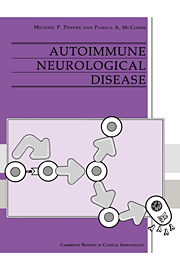Book contents
- Frontmatter
- Contents
- Preface
- 1 Antigen recognition and self–non-self discrimination
- 2 An introduction to neuroimmunology
- 3 Experimental autoimmune encephalomyelitis
- 4 Multiple sclerosis
- 5 Acute disseminated encephalomyelitis
- 6 The stiff-man syndrome
- 7 Experimental autoimmune neuritis
- 8 The Guillain–Barré syndrome and acute dysautonomia
- 9 Chronic immune-mediated neuropathies
- 10 Autoimmune diseases of the neuromuscular junction and other disorders of the motor unit
- 11 Inflammatory myopathies and experimental autoimmune myositis
- 12 Paraneoplastic neurological disorders
- 13 Neurological complications of connective tissue diseases and vasculitis
- Index
5 - Acute disseminated encephalomyelitis
Published online by Cambridge University Press: 22 September 2009
- Frontmatter
- Contents
- Preface
- 1 Antigen recognition and self–non-self discrimination
- 2 An introduction to neuroimmunology
- 3 Experimental autoimmune encephalomyelitis
- 4 Multiple sclerosis
- 5 Acute disseminated encephalomyelitis
- 6 The stiff-man syndrome
- 7 Experimental autoimmune neuritis
- 8 The Guillain–Barré syndrome and acute dysautonomia
- 9 Chronic immune-mediated neuropathies
- 10 Autoimmune diseases of the neuromuscular junction and other disorders of the motor unit
- 11 Inflammatory myopathies and experimental autoimmune myositis
- 12 Paraneoplastic neurological disorders
- 13 Neurological complications of connective tissue diseases and vasculitis
- Index
Summary
Introduction
Acute disseminated encephalomyelitis (ADEM) (post-infectious encephalomyelitis or post-vaccinal encephalomyelitis) is an acute inflammatory demyelinating disease of the central nervous system (CNS) (Johnson, Griffin & Gendelman, 1985). Typically it follows infection by a virus, but it may also follow infection by other agents or may complicate vaccination. Sometimes it occurs without any obvious triggering factors. The clinical manifestations are diverse and include presentation with acute transverse myelitis. Acute haemorrhagic leukoencephalitis is a rare and more severe form of ADEM with a high mortality and morbidity (Hurst, 1941; Johnson et al., 1985). There is good evidence that ADEM and acute haemorrhagic leukoencephalitis are autoimmune diseases similar to acute experimental autoimmune encephalomyelitis (EAE) and hyperacute EAE, respectively.
Clinical features
Triggering factors
Viral infection
Typically ADEM follows a viral infection such as measles, chickenpox, rubella, mumps, influenza or Epstein–Barr virus infections (Johnson et al., 1985). It may also follow upper respiratory tract infections of undetermined aetiology, Mycoplasma pneumoniae infection and bacterial infections (Johnson et al., 1985). Prior to the eradication of smallpox and the discontinuation of smallpox vaccination, smallpox and vaccinia were also important triggers of ADEM. In regions of the world that do not have a successful measles vaccination programme, ADEM complicates about one in 1000 measles virus infections (Johnson et al., 1984).
- Type
- Chapter
- Information
- Autoimmune Neurological Disease , pp. 155 - 165Publisher: Cambridge University PressPrint publication year: 1995
- 5
- Cited by

